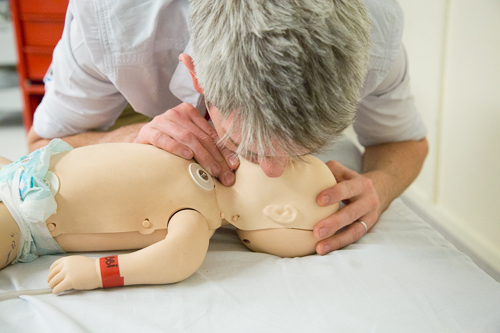LookListenFeel |
Respiratory effort should be assessed by:

If adequate respiratory effort resumes after opening the airway the rescuer should put the patient into the recovery position, maintaining the patent airway and frequently assessing breathing whilst they await help.
It is important to remember that not all respiratory effort is effective. Ineffective, obstructed or gasping breathing should be managed the same way as if there were no breathing at all.
Once the airway is open and it has been established that there is no adequate respiratory effort, 5 rescue breaths should be delivered to the patient.
Special considerations: In adult BLS the first intervention to an unresponsive patient is chest compressions. This is different to children, where five rescue breaths are given first. This difference in approach is as a result of the variation in pathologies that result in cardiorespiratory arrest in both children and adults. Adults tend to have a cardiac arrest secondary to a primary cardiac pathology, whereas cardiorespiratory arrests in children are more-likely hypoxic in nature.


For mouth-to-mouth, the rescuer should cover the patient’s mouth with their own, ensuring a good seal. The soft parts of the nostrils should be pinched to ensure no air leaks out through the nose.
The rescuer should breathe out slowly for one second, and just fast enough to make the chest rise. If the chest is inflated too fast air may inflate the stomach, and increase the risk of aspiration of gastric contents. The rescuer should take a breath in after each administered breath given to the patient, to maximise the oxygen content of the rescue breaths.
Special considerations: In infants, whilst giving rescue breaths, the rescuer may cover both the infant’s mouth and nose with their mouth.
The chest should rise during each breath, as much as would rise in normal breathing.
If the chest doesn’t rise then the rescuer should reassess the airway position, and ensure it is open using the techniques described above. Should the chest not rise despite appropriate airway manoeuvres then the possibility of an airway obstruction, secondary to an inhaled foreign body, should also be considered.
Whilst administering the rescue breaths the rescuer should be alert to any signs of coughing or gagging, as these actions form part of the signs of life assessment, which is to come.
In a hospital setting resuscitation equipment is often kept at the bedside and therefore using more advanced airway and ventilation equipment (e.g. bag-valve mask device) can be employed when commencing BLS. These are covered in later chapters.
Length of breaths in paediatric BLS: Once rescue breaths have been given and on entering a full cycle of BLS the ratio is 15:2 (compressions:breaths) and the duration of delivering a breath is about 1 second.
Safety consideration: At times a single rescuer may find that they are required to maintain airway and give breaths without Bag-valve Mask (BVM). This may pose a health risk to the rescuer (e.g. infection). Therefore the rescuer should only perform mouth-to-mouth if willing and able and their own safety is considered. If mouth-to-mouth is felt inappropriate then the rescuer should shout for help and commence compression only CPR until equipment arrives.